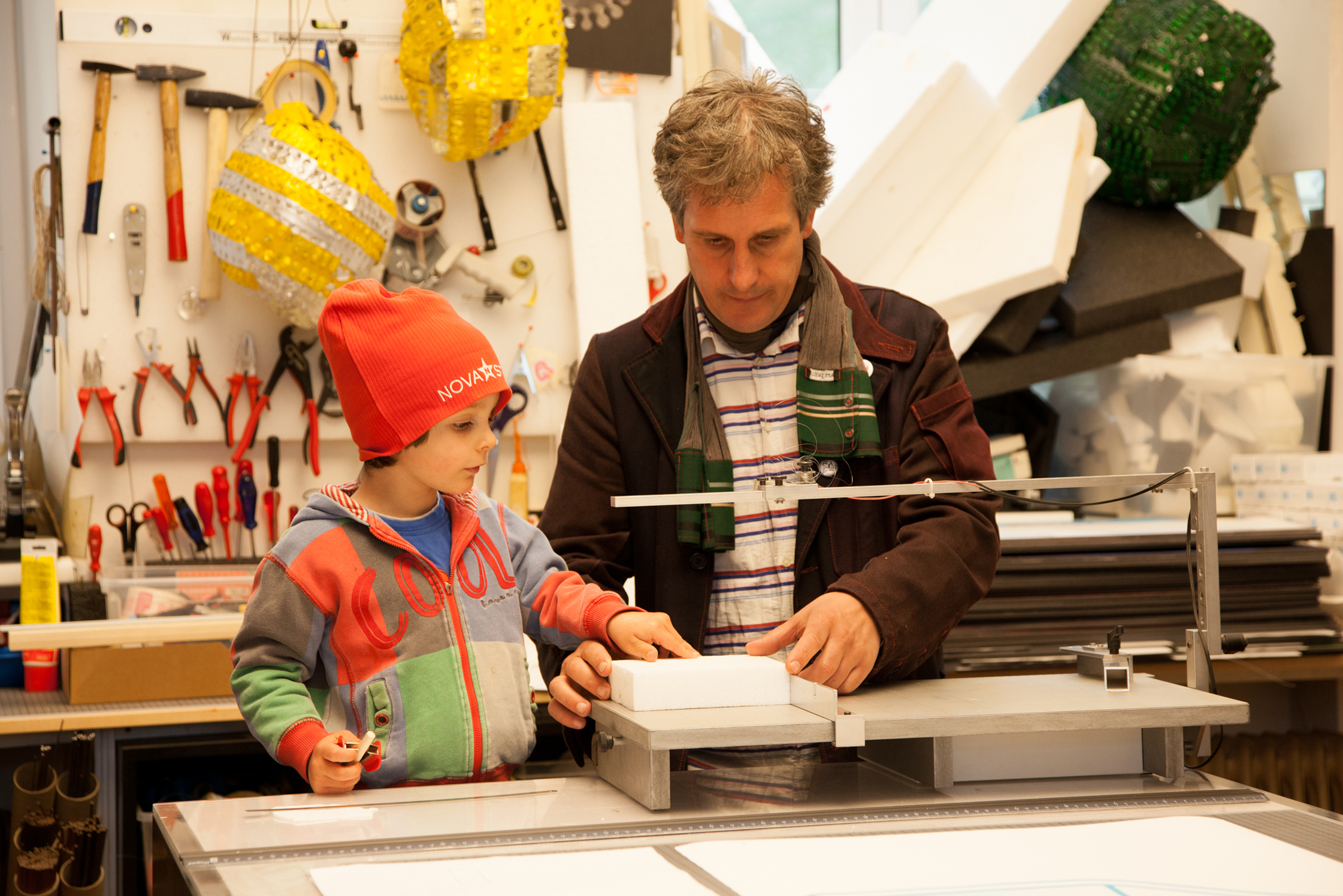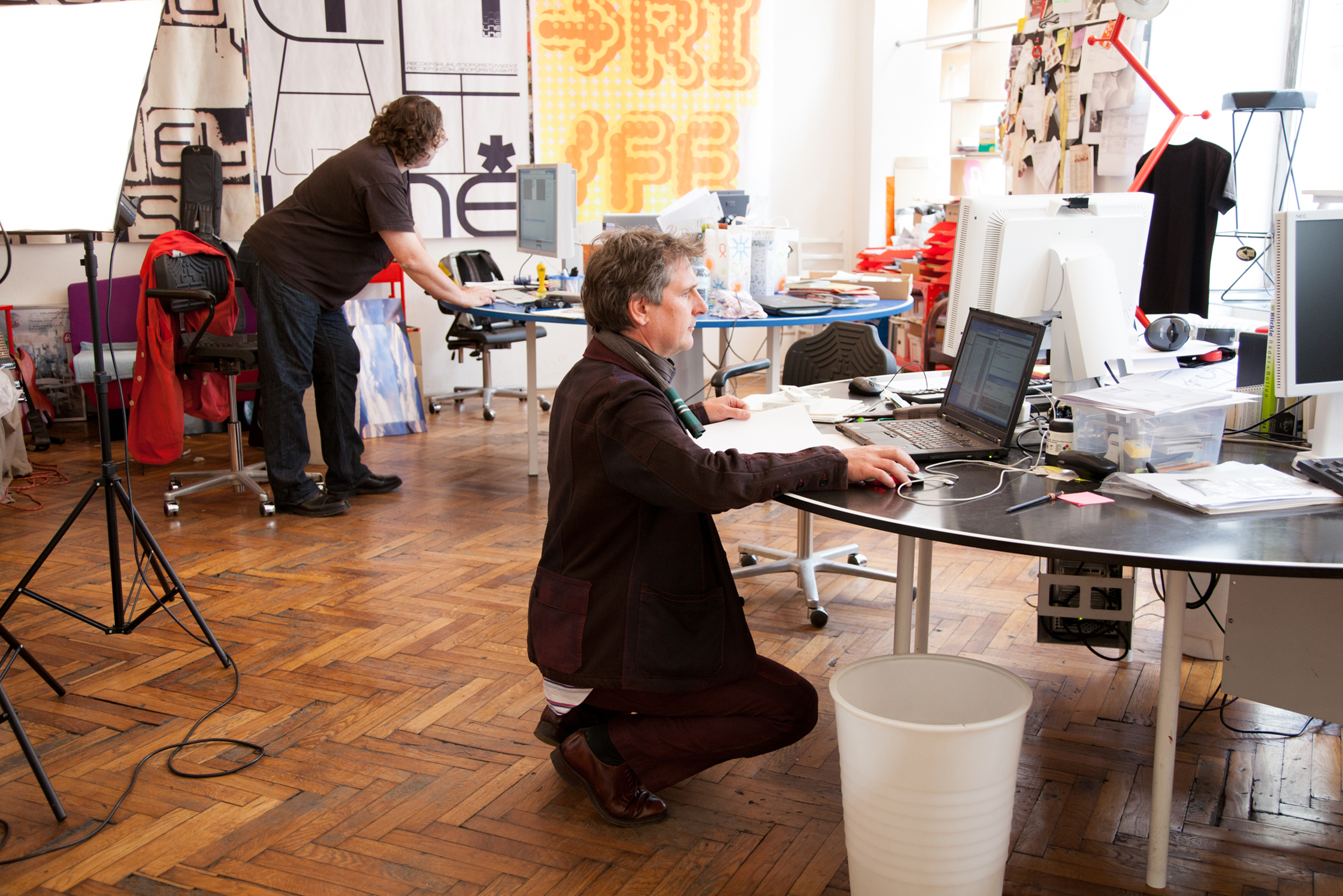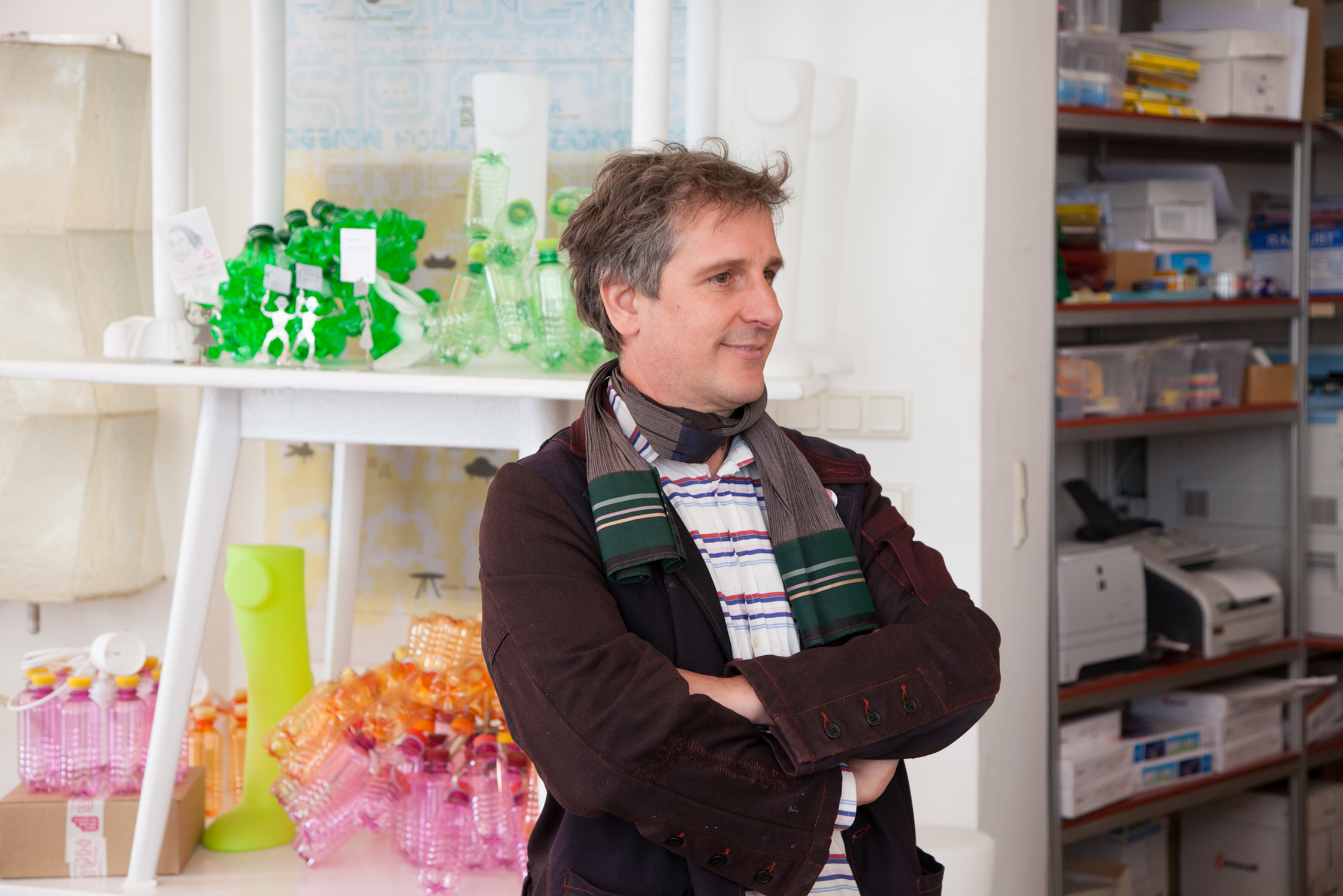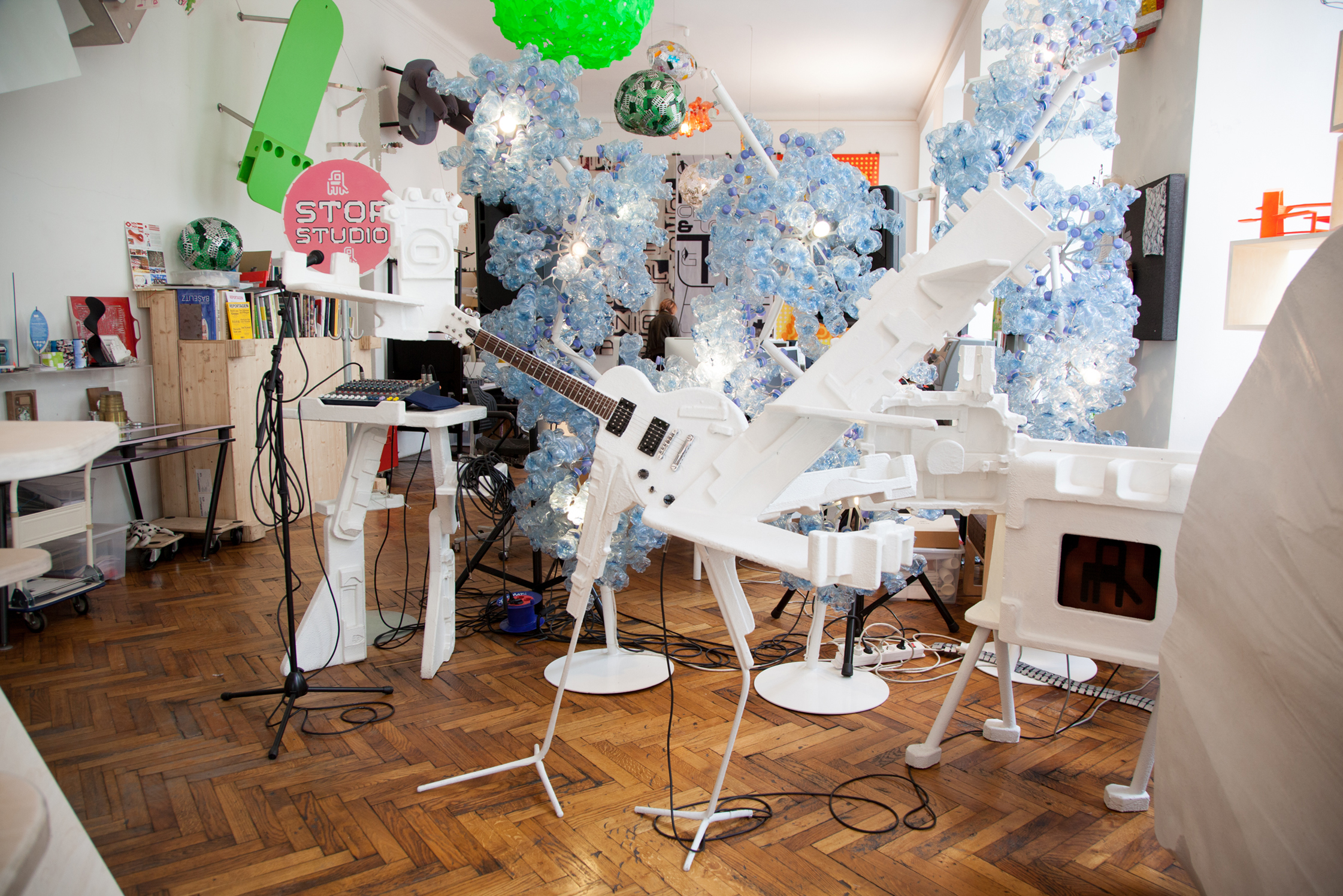Revolution needs more art! Fidel Peugeot and Karl Emilio Pircher have been working with this in mind for the past ten years at their design studio ‘Walking Chair’ in Vienna – that incidentally has lead to a minor, colorful revolution itself. Their playful design and colorful furniture exist at the nexus between directed creation and a playful and fun design language. Their best known piece, ‘Ping Meets Pong,’ a round table tennis plate, and the ‘Walking Chair,’ are studio icons and have even made it into a few museum collections.Both men aren’t originally from Vienna, however, have definitely managed to stir up the third district’s design scene with Walking Chair. Close by to the baroque castle Belvedere and Park complex, directly between the Wittgenstein house and the Hundertwasserhaus, typography and music are created through product and graphic design in a former coffee house. This diversity of focus plays a large role in their business regardless of the designer emphasis, echoed in their apt motto: ‘We make things and music.’ The two men have also recently been increasingly occupied with architecture and interior architecture. Their gallery, ‘Walking Chair Gallery,’ exhibits pieces by emerging designers and artists.During our conversation with Fidel and Karl Emilio, we learnt about the political side of design and why they think everybody with a computer can be considered a graphic designer. A true surprise awaited us behind these old Viennese building facades.



























When and why did you come to Vienna?
Karl Emilio: I came for my studies at the University of Applied Arts. I studied here for eight years in the area of product design, taught by Ron Arad.
Fidel: I came by train from Paris to Basel in 1992. It was just for short shoot. Since then, the city has never let me go. To narrate this in detail would be an interview in itself.
How did your collaboration come about?
Karl Emilio: We met at Lomography in Vienna in 2000.
Fidel: That was around the time where everybody began to be concerned with technology quite seriously. We were invited to develop a telephone. I saw Karl Emilio – I can still remember it well – at Cafe Sperl for the first time. It was a Thursday. By Friday we were already sitting in the kitchen of his student flat and talking about our first strategies of the aforementioned telephone.
What has happened to it?
Fidel: Unfortunately the project became impossible after the terror attacks on September 11. But we decided to collaborate regardless of our totally diverse design directions. In 2002, we presented ‘Walking Chairs’ together at Designerblock in London and a year later we launched our design studio.
What was your first joint project?
Fidel: Our first collaboration came into existence out of an invitation to exhibit in Tokyo. I worked on the action-sampler-typography and Karl worked on the super-sampler-camera. It was an analogue camera which could shoot mini animation films. The first proper studio job was for Marien Pharmacy in Vienna. We have been developing many things for them over the last ten years. This entails their interior architecture and their corporate and product design. For instance, the ‘Sister-Blister Lamps,’ that were made from leftover medication wrappers. This product is another story on its own.
What has changed in your work process since then?
Fidel: Nothing (laughs).
Karl Emilio: We don’t really have a structured working process as such. Every project is new and therefore requires an individual approach. The only thing that has changed is experience, which naturally has some sort of impact on the overall process. But there is no ready-made process.
Fidel: I have to disagree. There is a ready-made process. The first step is to question what the clients wants and our own perception. Once these needs are clear, we can get started. Depending on the project, one decides what direction to go in. Design emerges from ideas. We say that ‘Design follows content.’ That is our way of working!
Do you sometimes know what direction a project will go in beforehand?
Fidel: No, that is always open and can lead in a direction that we have never gone in before. It is also important that we work together with our clients. We have a huge advantage because we are both experienced in design craftsmanship. We don’t develop anything via fast-food-design on the computer. Nowadays anybody who can turn on a computer is a graphic designer. In only a few seconds, we become musicians, product designers, and copywriters. Today it is rare to find someone who can play an actual instrument, build something with their bare hands, or even write by hand. One needs to excel in something in order to succeed with a project.
Success – what does that mean to you?
Fidel: Success depends on the goal. In the beginning of our career we were happy just to have clients with whom we could have good conversations with and who would open up our perspective. Our success has grown with our work. It’s being talked about. It doesn’t matter whether it is being criticized or praised. We have a freedom to move with our work through the collaboration with artists despite working in the ‘design field’.
Karl Emilio: I don’t see a difference between designers and artists – it’s the principle of the idea. Having the right idea is naturally something… (laughs). It is like a form of internal training for us. You have to be able to quickly say yes or no. That is a filter we use with everything.
How can you tell what is a good idea?
Karl Emilio: All my good ideas – at least the ones that I regard as good afterwards – were always created during a moment of freedom. If there is anything like truth, then it is found through freedom. It is a complicated game and it took me a long time to figure out. Only a short moment is needed for that. For example, when a client walks in the very first impression you have is often the best one.
You work in many fields. Is there a common thread within your work?
Fidel: We don’t want a common thread. It would be something that would hinder us. Perhaps our common thread would be the fact of knowing our own limits and requirements, which are not for sale. We try to preserve the freedom and integrity of everybody involved. This is the only way we can create new things and contribute something to society. We don’t produce unnecessary things. We invent products that can be used as tools that can enrich someone’s life. Incidentally, we don’t see each other as the weakest part within the design chain. It is the client who decides his or her personal needs. We consequently entitled our book ‘You Do Design You’ and only noted at the very back of it a quote from our song: “We Do Design.”
Karl Emilio: Exactly, we only do that because we can be represented. We refuse to give into a specific style direction or any sort of ideology. Whether it is freelance work or an industry product, we stand behind our work.
So freedom plays an important role?
Fidel: Yes, It is the most important thing to us. Ludwig Hevesi’s statement on the building of the Viennese Secession: “To the age its art, to arts its freedom “ – it stills remains like that. We try to live by a certain freedom within our realm and work with relevant techniques. This is why we are often compared to recyclist-artists. Additionally, we create long-term products. Even if we create something completely new, it is a product that will last.
Karl Emilio: Exactly, we want to create products that are sustainable. It’s not about making something short, fast, and in large quantities. It is about creating specific products with quality, which then ensure their longevity within the market.
Are there any politics behind your work?
Karl Emilio: Of course, every work is very political. That was one of the reasons why I decided to pursue design and not art. I wanted to change things within society. Back then, when I was an assistant for a known artist, I realized at exhibitions that it would always be the same people that would meet and shake hands. Of course they are cool but where was the revolution? The most exciting thing here is to start a process with people from this environment. This is how something new within society is created.
You believe that you create things from the very heart of Vienna.
Fidel: The work is influenced by it’s environment – working in this atmosphere of horse-drawn carriages and proud waiters at coffee-house who ignore you because you are not originally from here rubs off. We are newcomers, meaning migrants within a bourgeois society. Even on my first day I was so exhausted I wanted to leave. I didn’t understand the city’s dimness. In 1992 everything was quite different. It was grim. But there is a lot of profoundness and humaneness in this city which we wish to present. This is why we say: “Best regards from the heart of Vienna.” It has become somewhat of a cliche in our emails. For instance, we colored a photo of our studio’s building from the 19th century in pink and published it as a postcard. This could be deemed inappropriate for a ‘modern’ designer, and many probably laughed at us for that. But after all we are located behind a 19th century facade, like almost everyone else in Vienna.
What happens behind the Viennese facade?
Fidel: Something completely different which is the exciting part of it all: people shape the future despite living in a 19th century backdrop. Modernity is everywhere in Vienna, one just has to look for it. But the city also profits from its past. There are so many things in the extensive collections of archives and museums. This notion still gives me goosebumps when I walk through Vienna. I would never have the same reaction anywhere else. There is always something new to discover.
You have a gallery right next to the studio. What do you use it for?
Fidel: We show about three to four exhibitions a year which we also curate. We like to show other designers works. The gallery provides us with the opportunity to exchange thoughts with our peers. It also serves as a cultural contribution to Vienna.
So you wouldn’t describe your work as typically Austrian?
Karl Emilio: Nowadays, one cannot say whether it is Scandinavian, German, or Austrian.
Fidel: There is only good or bad design. I like it or I don’t like it. If we talk about Scandinavian or Italian design, it is merely about the year-long marketing campaigns of individual regions that build up the brand.
Is there something like that in Vienna?
Fidel: Yes, the Vienna Business Agency Here, the city intends to make itself as attractive as possible through intelligent subsidy policies. It not only supports creative people and companies financially, but it also presents them to the international public. It is primarily about the artist’s marketing but also about the city’s growth. New ideas and solutions are created with the help of that agency.
What is a typical day at the studio like for you?
Karl Emilio: We work in a very concentrated way. There is no music.
Fidel: Music is coming.
Karl Emilio: Yes, but we will make it ourselves. But there is no noisy background atmosphere. We first think about the steps and then we work. This efficiency enables us to realize many projects. We work in a small team and enjoy receiving feedback about our work and sharing ideas.
And after work?
Fidel: When I leave the office, I am satisfied. I like to sit down with my instrument and create music. I also like to concentrate on different things. Recently I have discovered how important this time is. I have had a dog for one year, which I take out on walks. I would have never done that back in the day. But it gives you another perception. It should be appreciated.
Karl Emilio: Yes. Where does work start and end? It is difficult to answer when it comes to the creative industry. But the same question could be asked about stress. As well as freedom, and peace.
Is there time to play around in all this efficiency?
Karl Emilio: That is a tricky question. What does it mean to play? In general, playing is related to a childish form of building and crafting. If we would cut something by hand or build a model, it would be considered playing. But there is also a certain play when writing a text or an email. That is the game of words. Life is a game, the playground just has to be laid out in front of you. But if you ask me like that, ‘do I play?’ I would say yes.
Karl Emilio: Playing is the wrong term. I would rather speak of freedom. The freedom of being able to decide and take responsibility is a form of playing. Now, one could be polemic and say that there are two types in society: the player and the one who develops the game. I would belong to the second one. I don’t like to constantly play a game. Of course, sport is fun. But I don’t belong to any club. I don’t sit and play at a computer. I am just not interested in these type of games. My game is to sit at a CAD program and build new 3D parts. In the end I ask myself, does it or doesn’t it work? Okay. That is some sort of game. Perhaps like a child plays with Lego. You basically do the same as an architect. The important thing is to create something new, from something that you don’t know the pattern of. It cannot be clear from the beginning, there has to be a risk. One tries to cross limits. For example, furniture that doesn’t look like regular kind of furniture.
Thank you for giving us insight into your work process, Fidel and Karl Emilio! If you want to know more about their projects, please go here or visit their studio, gallery, or shop.
This portrait was produced in collaboration with the Vienna Business Agency and its creative center departure. You’ll find more portraits and reports from Vienna’s creative scene here.
Photography: Lukas Gansterer
Interview & Text: Philipp Daun
